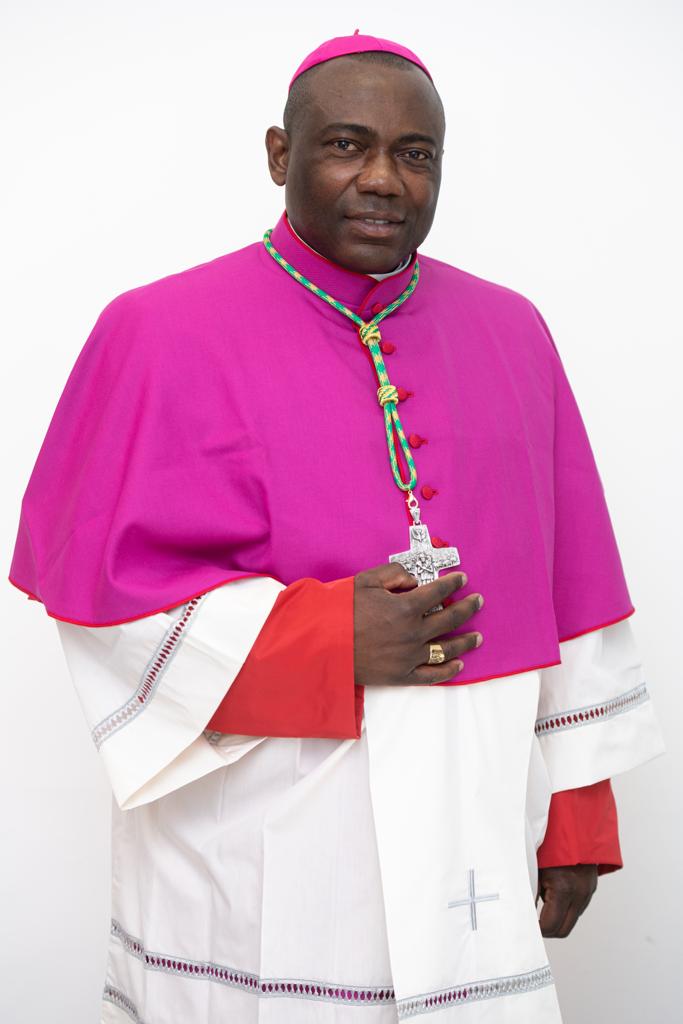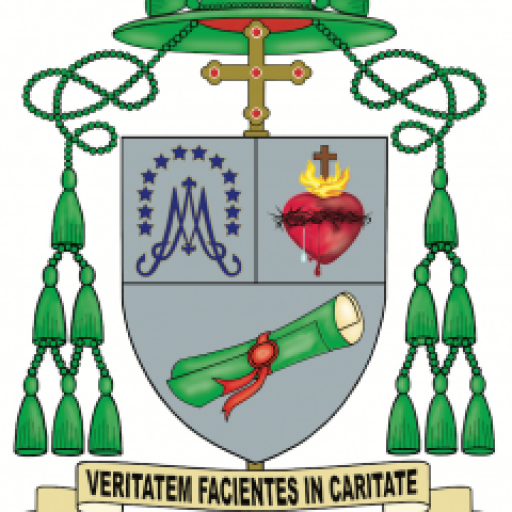Bishop Aloysius Fondong is the third Bishop of the Diocese of Mamfe

Bishop Fondong was born on Tuesday 5 June 1973 in Molyko-Buea. He is the third child among the nine children of Pa Joachim Njiaka Fondong and Ma Rose Asong Awung.
He was baptized a Catholic Christian in Muea on 1 July 1973, by Fr. Francis Teke Lysinge and received First Holy Communion on 6 February 1983, in Debundscha, from Fr. Alois Mitterer (MHM). On 25 November 1984, he received the sacrament of Confirmation in Bota, from his Lordship Pius Suh Awa. He did his primary school education in the following schools: Catholic School Ikata and Presbyterian School Debundscha. The young Aloysius was admitted into the following colleges for secondary school education: National Comprehensive Secondary School Limbe 1987/88, Government Secondary School Muyuka 1988/92. Bilingual Grammar School Molyko-Buea 1992/94. After obtaining the Advanced Level Certificate in 1994, he spent the year 1995 teaching at Vocational College of Arts Science and Technology (VOCAST) Muyuka.
In 1996, the young and enthusiastic Aloysius was admitted to Bishop Rogan Minor
Seminary as a prospective candidate for the priesthood, for the diocese of Buea. He was later admitted into St. John Mary Vianney Spiritual Centre Njinikom, in 1997, to undergo the spiritual year of formation for the Catholic priesthood. The next year, he was admitted, as a major seminarian, to the Saint Thomas Aquinas’ Major Seminary Bambui. After his philosophical studies in the year 2000, he was sent on pastoral experience to Sacred Heart Parish Fiango-Kumba. In 2001, he went back to the Major Seminary in Bambui to study theology.
On 29 June 2005, he was ordained a transitional deacon by his lordship Francis Teke Lysinge, in the Saint Joseph Metropolitan Cathedral in Bamenda. Thereafter, he spent another year of pastoral experience in Saint John the Evangelist Parish Kumba-Town. On Thursday 20 April 2006, in the Regina Pacis Cathedral Soppo-Buea, Rev. Aloysius was ordained a Catholic priest by His Eminence Christian Cardinal Tumi. Before his appointment as bishop of Mamfe, Fr. Aloysius served the Church in Buea and the entire Ecclesiastical Province of Bamenda in the following ways:
(I) For the Diocese of BUEA
* Parochial Vicar, Holy Family Parish Limbe-2006-2007.
* Principal, Our Lady of Grace College Muyuka-2007-2009.
* Lecturer, St. John Paul II Institute of Theology Molyko-BUEA-2007-2011.
* Buea Diocesan Financial Administrator-2009-2011.
* Member of Buea Diocesan College of Consultors – 2009-2011.
* Buea Diocesan Chaplain for World Apostolate of Fatima-2007-2011.
(II) For the Ecclesiastical Province of BAMENDA
* Lecturer of Canon Law for the Provincial Major Seminary: The Saint Thomas Aquinas’ Major Seminary, Bambui-Cameroon: from September 2014 – June 2019.
* Defender of the Bond for the First Instance Tribunal of the Bamenda Ecclesiastical Province: from August 2014 – June 2019.
- Shield: Silver – signifying Truth, Love, and Transparency. The vocation of every Christian is to glorify God in this earthly life and to enjoy God forever in heaven. To faithfully fulfill this vocation, the Christian must struggle to become more like Jesus Christ, the One in whom we live and move and have our being, the One who teaches us how to glorify God. To glorify God presupposes a certain transparency. However, this transparency is only possible to the measure in which the life of the believer is guided by Truth and Love, the two fundamental principles on which the life and mission of Jesus Christ were anchored. Thus, only by living the truth in love will the believer truly glorify God in this life and enjoy God forever in heaven.
- Scroll: my motto: Veritatem Facientes in Caritate. This phrase, taken from the letter of Saint Paul to the Ephesians (4:15) expresses the profound Christian doctrine that “If we live by the truth and in love, we shall grow completely into Christ, who is the head”.
- Blue Monogram with 12 Stars: Representing Our Lady of Fatima and Queen of the Rosary, under whose protection I dedicated my priestly ministry and now my episcopal ministry. Considering that I have been appointed Bishop within a very difficult moment in the history of Cameroon, the fact that the territory of the diocese of Mamfe has experienced the worst casualties in the so-called “Anglophone Crises”, and the fact that the Blessed Virgin Mary is the principal
patroness of Cameroon, I strongly believe that the wisdom to resolve this stalemate is found in true devotion to Our Lady of Fatima who clearly instructed: “Say the Rosary every day, to bring peace
to the world and the end of the war”. - The Heart: The heart symbolizes love, the true vocation of every believer. In the life and mission of Saint Joseph, the patron of the diocese of Mamfe and patron of Muyuka parish – my home parish in the diocese of Buea, we have a perfect example of what Christian love entails. Only those who truly love their neighbours, those who are genuinely ready to sacrifice their ambitions, projects, interests, and comfort zones will truly merit the title of “man or woman of honour”. Indeed, in the life of Saint Joseph, we have a practical example of disinterested Love, the way that leads to lasting peace in one’s soul, in families, and nations.
- External ornaments:
a) Gold cross behind the shield with one transverse arm: The Cross is a powerful sign of divine love and the weapon of salvation for the believer. No amount of prayers or good deeds could ever make us more fit for Heaven than what Jesus did and completed on his own on the Cross. There is no other way for the believer to glorify God here on earth and to live with God forever in heaven
than the way of the Cross. Walking the way of the Cross presupposes a decision that is made in truth
and in love.
b) Ecclesiastical hat or galero with six tassels on either sideall in green, the traditional “bishops’ colour”: The colour green is naturally seen as a sign of life, hope, growth, renewal, peace, and restoration which radiate from the heart of the bishop, the chief Shepherd in his diocese.
c) Cream coloured scroll tied in a green card and sealed in red: This is the traditional symbol for Canon Law, the ecclesiastical science which has greatly shaped my life and priestly ministry. Canon Law serves no other purpose than to create a just order in which truth and love, grace, and charismatic gifts can be harmoniously developed and preserved with the ecclesial community.
d) Interior of the hat scarlet: The scarlet colour represents the martyrdom, whether real or spiritual, which all bishops are called to at the time of their consecration to the dignity of the episcopate. The scarlet colour is also associated with courage and passion, the virtues that best express how I live the truths contained in the Catholic faith.
